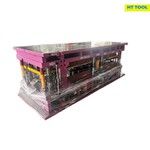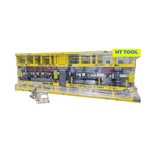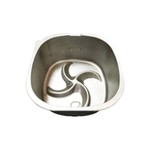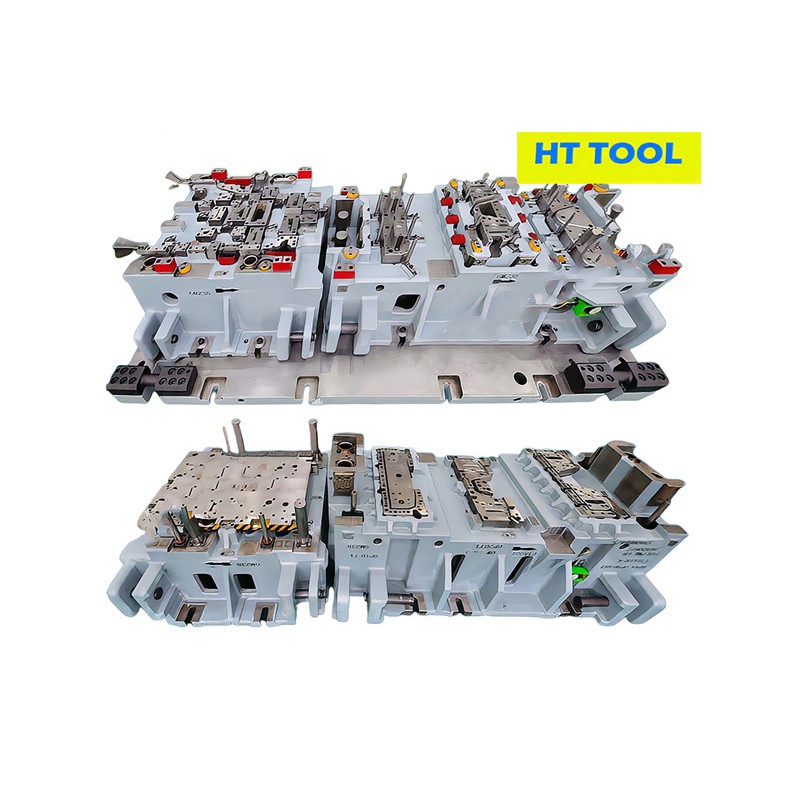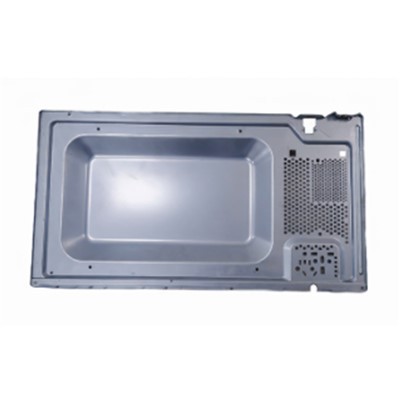Stamping Die
Company Profile
HT TOOL is highly experienced with Progressive Tooling from medium to high complex parts up to 1300mm width. Our costumers can expect to achieve the maximum productivity/quality from our progressive tools.
Why Choose Us
Rich Experience
Continuously providing our customers with diverse and highest quality die making services and delivering first-class metal stamping dies and parts with precision, accuracy, speed and efficiency.
One-stop Solution
HT TOOL is committed to providing reliable one-stop solutions for the tool and die industry, and through our strengths to become the preferred supplier within the metal stamping die industry.
Professional Team
In tooling design department, we are able to provide a comprehensive service to our customers. Our project managers (x2) are in permanent contact with our customers during the project development process and during the mass production of the dies.
Customized services
Our assembly units offer maximum flexibility to meet our customers' needs, adding value to each part with customer satisfaction in mind.

A stamping die is a unique precision tool, which is used to cut metal sheet and form it into a particular shape. Dies contain cutting and forming sections that are usually made from special hardenable steel, known as tool steel. These cutting and forming sections can also be made from different hard wear-resistant materials, like carbide.
Stamping is a cold-forming process, in which heat is neither used on purpose into the die nor the sheet. However, since the cutting and forming process entails friction, which in turn generates heat, stamped parts that leave the dies are often very hot.
Benefits Of Stamping Die
'lt is awesome to work with Creative. amazingy organized,easy to communicate with. responsive with next iterations,and beautiful work.
High precision
Stamping dies are designed to produce high-precision components and parts. They enable manufacturers to achieve tight tolerances and ensure accurate and consistent dimensions in each stamped piece.
Versatility
Stamping dies can be used to produce a wide range of complex shapes and sizes. They are adaptable to various materials, including metals, plastics, and composites, making them versatile for diverse manufacturing applications.
Speed
Stamping dies enable high-speed production, as they can rapidly stamp out multiple parts in a short period. This helps to meet production demands and reduces lead times.
Durability
Stamping dies are typically made of hardened tool steel, which makes them highly durable and long-lasting. They can withstand high-pressure forces during the stamping process without losing their shape or functionality.
Type of Stamping Die
Progressive Stamping Dies
In progressive stamping operations, each station in the die performs a specific task within the press. Once the task is completed, the workpiece is automatically moved to the next station. This process gradually forms and cuts the material until it has been turned into the desired component. At the final station, the component is cut free from the larger piece of material.
Transfer Stamping Dies
The transfer die stamping process is highly similar to the progressive die stamping process; components are produced by passing the workpiece through a series of consecutive stations within a single die. The main difference between the two processes is that the component is cut from the sheet metal at the beginning rather than the end. Parts are then transferred through the stations manually, robotically or with some mechanical means.
Simple Stamping Dies
Simple stamping dies are designed to perform one operation per stroke of the press. They are ideal for basic jobs, like blanking or piercing, but are not suited for larger applications.
Compound Stamping Dies
Compound stamping dies are designed to perform multiple operations per stroke of the press. They are better suited for complex or demanding jobs than simple stamping dies since they can complete the job faster. However, while they can handle cutting operations (e.g., blanking and piercing), they are not ideal for forming operations (e.g., bending).
Combination Stamping Dies
Combination stamping dies are similar to compound dies. They can perform multiple operations per stroke of the press. However, they are suitable for both cutting and forming operations, meaning they can be used for blanking, piercing, bending, and forming.
The Ubiquitous Applications of Stamping Dies
The company conducted a competitive advantage analysis to identify its strengths and weaknesses compared to its rivals.
Automobile Manufacturing Industry
Stamping dies are widely used to manufacture auto parts, doors, hoods, seat frames, and other components.
01
Home Appliance Manufacturing Industry
Stamping dies are extensively used to produce the shells and components of household appliances such as refrigerators, washing machines, and air conditioner casings.
02
Electronics Manufacturing Industry
Stamping dies are used to produce the shells and structural components of electronic products such as mobile phone casings, laptop casings, and tablet casings.
03
Machinery Manufacturing Industry
Stamping dies are widely used in the production of various machinery, tools, and components.
04
New Energy Sector
Stamping dies are widely used in the fields of new energy vehicles, photovoltaic equipment, wind power generation equipment, and more.
05
What Are the Two Basic Operations of Stamping Dies?
Forming
Forming operations using stamping dies involve reshaping flat sheet metal or other materials into desired three-dimensional shapes or profiles. Some operations include: bending, drawing, embossing, coining, flanging, hemming, stretching, and curling.
Bending operations using stamping dies involve folding the material. Bends can be simple/straight, curved/formed, and multi-step for complex forms. Deep or shallow drawing is a forming operation that involves stretching and shaping a flat sheet of material into a shallow or deep 3D shape. Embossing involves creating raised or sunken designs, patterns, or logos on the surface of the material. The die set has male and female dies with the desired design, and the material is pressed between them. Coining is a precision forming operation used to create extremely tight tolerances, smooth surfaces, and sharp edges on the material. Flanging operations involve forming a continuous raised or downturned edge on the perimeter of a workpiece. Hemming is a process of folding and bending the edge of a workpiece back onto itself, for rigidity or cosmetic reasons. Stretching is similar to shallow drawing, involving pressing ridges into sheet material to add stiffness. Curling is used to create curled or rolled edges on a workpiece.
Cutting
Cutting operations using stamping dies involve the removal of specific shapes or sections from a sheet. These operations are crucial for producing precise parts and components with clean edges. Cutting operations include: blanking, piercing, notching, trimming, shearing, lancing, slitting, and perforating.
Blanking is a cutting operation that removes a flat piece, or blank, from the sheet. The stamping die consists of a flat-faced punch and a die. Piercing involves creating holes or openings in the material using a punch and die set. The punch often has an angled face that makes the cut slightly progressive from a point. Notching operations cut small, V-shaped, or U-shaped notches in the material. This is often used for creating tabs or slots that facilitate assembly and is again performed with an angle-faced punch. Trimming is the process of removing excess material from the edges of a workpiece to achieve the final desired shape. Shearing operations cut the material along a straight line to separate it into smaller sections. Lancing involves creating a partial cut or notch in the material, used for creating tabs or hinges in components like lids or covers. Slitting is a cutting operation that involves making long, straight cuts in the material to create narrower strips or coils. This is often performed by a powered roller shear but can be a cyclic linear blade process. Perforating operations create a pattern of small holes or perforations in the material and represent a subvariant of piercing.
Stamping die are a forming processing method that relies on presses and molds to apply external force to plates, strips, pipes and profiles to cause plastic deformation or separation, thereby obtaining workpieces (stamping die) of the required shape and size. Stamping and forging both belong to plastic processing (or pressure processing), and are collectively called forging.
Compared with castings and forgings, stamping die are thin, uniform, light and strong. Stamping can produce workpieces with ribs, ribs, undulations or flanges that are difficult to manufacture by other methods to improve their rigidity. Due to the use of precision molds, the accuracy of the workpiece can reach micron level, with high repeatability and consistent specifications, and holes, bosses, etc. can be punched out.
Cold stamping die generally no longer undergo cutting processing, or only require a small amount of cutting processing. The accuracy and surface condition of hot stamping die are lower than those of cold stamping die, but still better than castings and forgings, and the amount of cutting processing is small.
Stamping is an efficient production method. The use of composite dies, especially multi-station progressive dies, can complete multiple stamping processes on one press, realizing the entire process from strip uncoiling, leveling, punching to forming and finishing. Automatic production. The production efficiency is high, the labor conditions are good, and the production cost is low. It can generally produce hundreds of pieces per minute.
Stamping is mainly classified according to process and can be divided into two categories: separation process and forming process. The separation process is also called blanking. Its purpose is to separate the stamping die from the sheet along a certain contour line while ensuring the quality requirements of the separated section. The surface and internal properties of stamping sheets have a great influence on the quality of stamped products. The thickness of stamping materials is required to be accurate and uniform; the surface is smooth, no spots, scars, scratches, no surface cracks, etc.; the yield strength is uniform and has no obvious Directionality; high uniform elongation; low yield-to-strength ratio; low work hardening.

Components of Stamping Die
Guide Plate Components
Main function: Guiding the raw material strip at the right location before feeding in tool, make the strip parallel with tool.
Punch and Die Components
These components will the main working components in tool, which used for cutting, piercing, forming, bending etc.
For high precision & high volume projects, these inserts will using carbide material which have high hardness, could good ensure the stamping components precision and long life time.
Stripper Plate Inserts
These tool parts are put into the stripper plate, used for accuracy guide punch, easy for tool adjustment. There are 3 types of structure: shoulder type, screw fix type, double layer type. The mostly use type is shoulder type.
Pilot Pin and Mis-feeder Detection Device
The function of pilot pin is make strip at correction position before tool 1 station working, and mis-feeder is a kind of sensor that can prevent tool shut while miss feeding, which can protect tool away from damage.
Main Guide Pillar & Guide Bush, and Sub-guide Pillar & Bush
Above stamping die components all are standard parts which used for tool guide. When stamping die working, usually will use the main guide pillar and post to make a initial guide, then use the sub-guide pillar and post to make precision guiding, which can ensure whole tool sets accuracy.
Limit Bolt
This stamping die component used for prevent tool damage while the die shut height wrong set, which can protect tool and tool inserts.
Guide Pin
The guide pin is used for material guiding while feeding into mold, also it have the function of material stripping.
Clamp Screw
The clamp screw function is to fix the various die component together, provide tight locking force to make the tool be stable while under pressing force.
Plug Screw
The plug screw usually together with spring in tool, which can limit the spring compression under the force, also it can adjustment the precompression height of spring
Stripper Spring and Stripper Screw
The stripper screw usually use inner thread type, this can not only used for fix stripper plate, also can disassembly the stripper plate. And the stripper spring will mainly provide enough pressing force and stripping force for stripper plate.

There are some tell-tale signs that a stamping tool may be in need of maintenance. These can include burrs on your parts, tolerances going out of spec, increased tonnage or hearing noises from your tool. The fix might be as simple as sharpening or could need a more in-depth trouble shooting to see why the tool is not operating as intended.
Sometimes the problem may only occur when the die is running, in that case, seeing the tool run in person or video footage of the die in action will be incredibly beneficial to diagnosing the issue. It could be how the tool is set up in the press, the press itself being worn, or prematurely wearing items due to the tool steel types used in the die.
There are several key pieces of information that would greatly help a tool maker trouble shoot your tooling. Most tool makers would appreciate the tooling design if it is available. At a minimum, part print and inspection report are great places to start. Another helpful piece of information is saving the last part from your production run along with the end strip. This will help the toolmaker investigate and zero in on the problem areas. Each tool has clues as to what may be happening. A good tool & die maker can help decipher those clues and tell that tool’s story.
Going forward, keeping a preventative maintenance schedule with your tooling can help reduce and catch these problems before they become large, expensive fixes. This information can also help predict when future PM might be needed so you can plan ahead and help reduce the downtime of your progressive metal stamping dies. This might include identifying higher wear items so you can have spare components ready to install into the tool as needed.
Our Factory
With ISO9001 certification and a mature design system. The press capacity is from 200T to 800T. Relying on a perfect quality control system. We strive to provide our customers the best product.We offer a wide range of Other Metal Stamping Dies products.
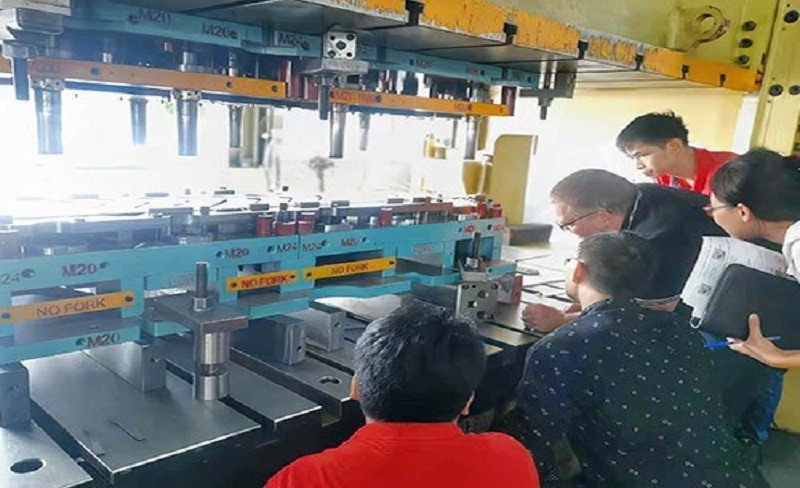


Certificate




